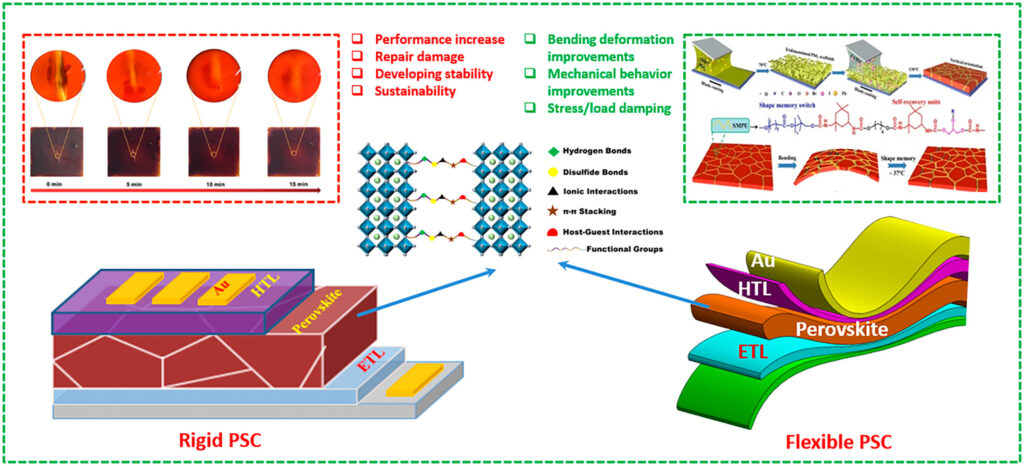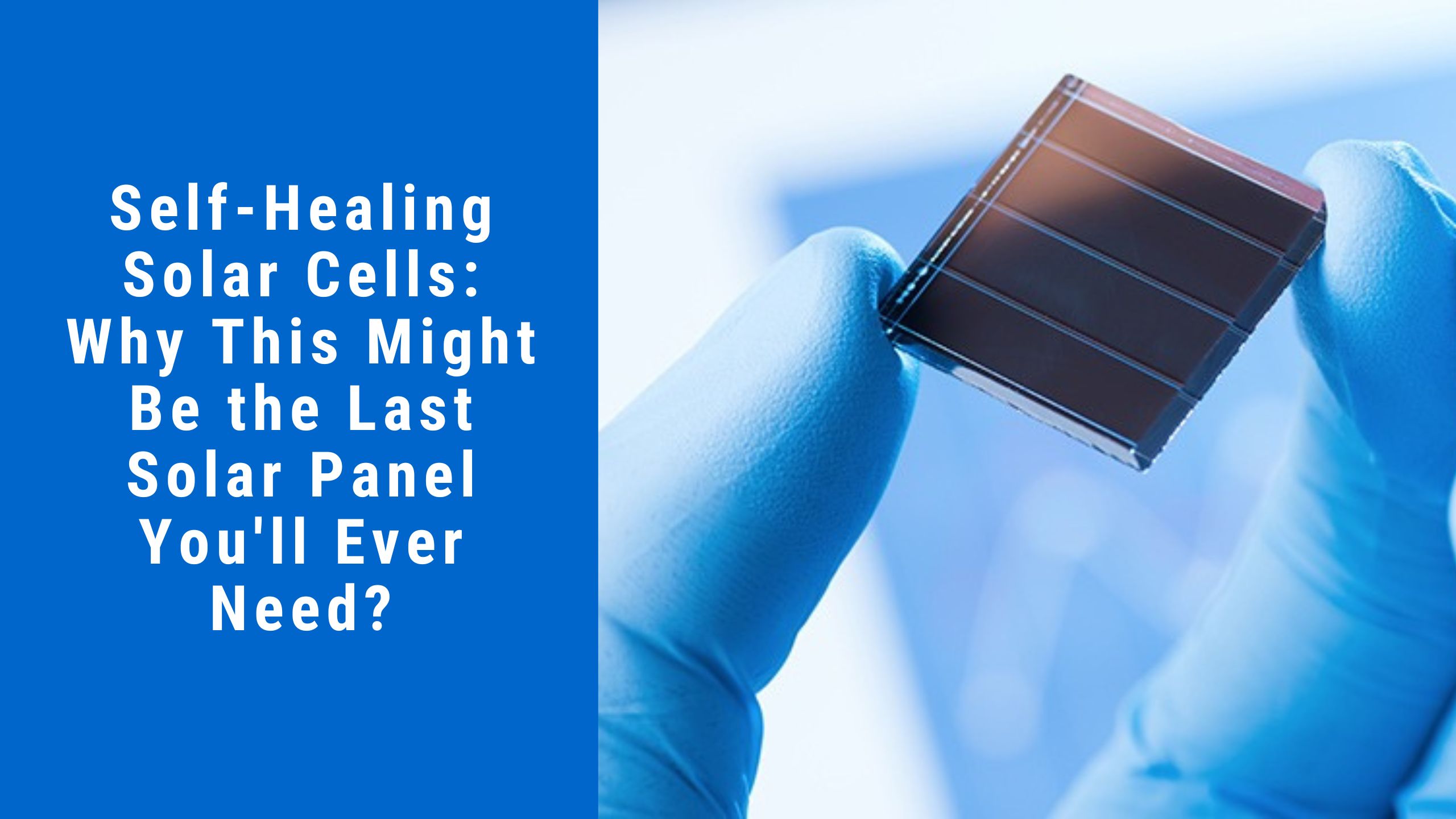Solar panels are engineered to last about 30 years, enduring decades of harsh weather and constant sunlight. But what if we could push that lifespan even further—potentially forever?
Imagine solar panels that can repair themselves, maintaining peak efficiency throughout their entire lifetime. This revolutionary idea is at the heart of a new generation of perovskite solar cells with self-healing capabilities. These innovations promise to reshape the solar industry, provided they can transition from the laboratory to the real world.
Why Do We Need Self-Healing Solar Panels?
Solar panels are remarkable technology, but even they are not immune to wear and tear. While they capture sunlight to generate power, the very sun that fuels them also takes a toll on them.
Over time, exposure to UV rays, heat, humidity, hail, snow, dust, and temperature fluctuations gradually degrade their efficiency.
On average, solar panels lose about 0.5% to 0.8% of their efficiency each year. This decline affects not just their lifespan but also their ability to deliver consistent, high performance.
When a single solar cell within a panel fails, replacing it is often impractical, especially in complex installations like satellites or space probes, where maintenance missions are costly or impossible.
Moreover, the very durability that helps panels endure decades also complicates recycling efforts, increasing environmental impact. Extending the functional life of solar panels through self-repair could reduce waste and improve the return on investment for solar energy systems.
The Origins of Self-Healing Solar Technology
The concept of self-healing solar cells dates back to 2010 when Professor Michael Strano from MIT drew inspiration from nature. Plants continuously repair their photosynthetic machinery, replacing damaged molecules within hours to maintain energy production despite exposure to harsh sunlight.
Strano’s team mimicked this dynamic process by creating “dynamic cells” using carbon nanotube scaffolds combined with light-sensitive proteins called phospholipids. Although the amount of electricity generated was minimal, this proof of concept opened the door for future breakthroughs.
More recently, researchers at York University discovered that antimony selenide, a solar-absorbing material, can self-heal damage, much like salamanders regrowing their limbs. The material repairs broken chemical bonds on its own, demonstrating a natural self-healing mechanism that could be harnessed for solar technologies.
HUBLA: The Self-Healing Compound Transforming Perovskite Solar Cells
One of the most exciting advancements comes from teams at Monash University, Oxford, and City University of Hong Kong, who developed a compound called HUBLA—short for Hydrogen-bonded Urea-Based Ligand Addition. This compound acts as a “living passivator” that repairs defects in perovskite solar cells when exposed to stressors like heat and humidity—ironically, the very factors that usually cause damage.

To understand HUBLA’s significance, it helps to know how solar cells work. Sunlight releases photons that excite electrons in the semiconductor material, creating free electrons and positive “holes.” Capturing these electrons produces usable electricity. However, tiny defects on the cell’s surface act like traps, causing electrons to recombine prematurely with holes, wasting energy.
HUBLA fills and smooths these defects, allowing electrons to flow freely and boosting cell efficiency. What makes HUBLA revolutionary is that it regenerates itself under environmental stress, continually repairing damage and maintaining performance.
“By slowly releasing passivating agents into the perovskite thanks to this compound, we produced solar cells with not only improved performance but also long-term stability under real-world conditions,” explained Professor Udo Bach from Monash University.
In accelerated aging tests at 85°C under simulated sunlight, HUBLA-treated cells retained 88% of their efficiency after 1000 hours, compared to just 50% for untreated cells after 400 hours. These results suggest that HUBLA could dramatically extend the useful life of solar panels.
Space-Grade Self-Healing Solar Panels: Sydney’s Breakthrough
Not all self-healing solar technologies are designed for Earth.
Researchers at the University of Sydney have developed perovskite solar cells tailored for space applications, where weight and efficiency are critical. Perovskite cells are lighter and often more efficient than traditional silicon panels, making them ideal for satellites and spacecraft.
However, space presents unique challenges. Without Earth’s atmosphere, solar panels face unfiltered, intense radiation that degrades materials rapidly. The Sydney team’s innovation lies in a self-healing mechanism activated by the heat and radiation in space. Specifically, their cells use a process called annealing—a controlled heating and slow cooling—to “relax” the crystal structure and repair damage.
The key player here is the hole transport material (HTM) layer, which guides positive charges inside the cell. Space radiation causes this layer to leak fluorine-like chemicals, disrupting the flow of charge. Remarkably, solar cells can utilize the sun’s heat and radiation to counteract this leakage, thereby restoring full efficiency without the need for human intervention.
Tests showed that these space-grade perovskite cells could fully recover their performance, reaching 100% efficiency after damage—a significant improvement over typical solar panels in orbit, which degrade by up to 10% annually due to radiation exposure.
From Lab to Market: Challenges Ahead
Despite these promising advances, self-healing solar panels remain largely experimental. Most technologies are still in early prototype stages, with limited real-world testing. Demonstrating long-term durability over decades, especially in outdoor environments, requires years of rigorous evaluation.
Scaling up production is another hurdle. Manufacturing self-healing perovskite cells reliably and cost-effectively will be essential for widespread adoption. Compatibility with existing solar infrastructure is also critical; new panels must integrate seamlessly with current systems to avoid costly retrofits.
Cost competitiveness remains a significant factor. Traditional silicon panels are inexpensive and well-established, so new technologies must offer clear benefits to justify any premium. Past solar innovations have faltered not due to technical failure but because existing solutions remained cheaper and simpler to deploy.
The Road Ahead: A Bright Future for Solar Energy
The potential of self-healing solar panels is immense. Longer-lasting, more efficient panels could reduce waste, lower energy costs, and accelerate the transition to clean power. While most innovations currently rank around 4 or 5 on NASA’s Technology Readiness Level—validated in lab environments but not yet ready for widespread use—the pace of progress is encouraging.
If development continues steadily, we might see the first commercial self-healing solar panels within the next decade. Such a leap would transform how we think about solar energy, turning panels from durable equipment into near-perpetual power sources.
In the meantime, practical solutions like the EcoFlow DELTA Pro Ultra and PowerPulse EV charger offer accessible ways to reduce energy bills and embrace solar power today. These systems offer powerful, easy-to-install home solar setups with intelligent management, enabling homeowners to save thousands of dollars annually.
Ultimately, the journey toward “forever” solar panels is well underway. With continued innovation and investment, the last solar panel you’ll ever need might not be just a dream but an imminent reality.
What Do You Think?
Are self-healing solar panels the future of renewable energy? How soon do you think they will be available on the market? Share your thoughts and join the conversation as we explore the exciting possibilities ahead in solar technology.


